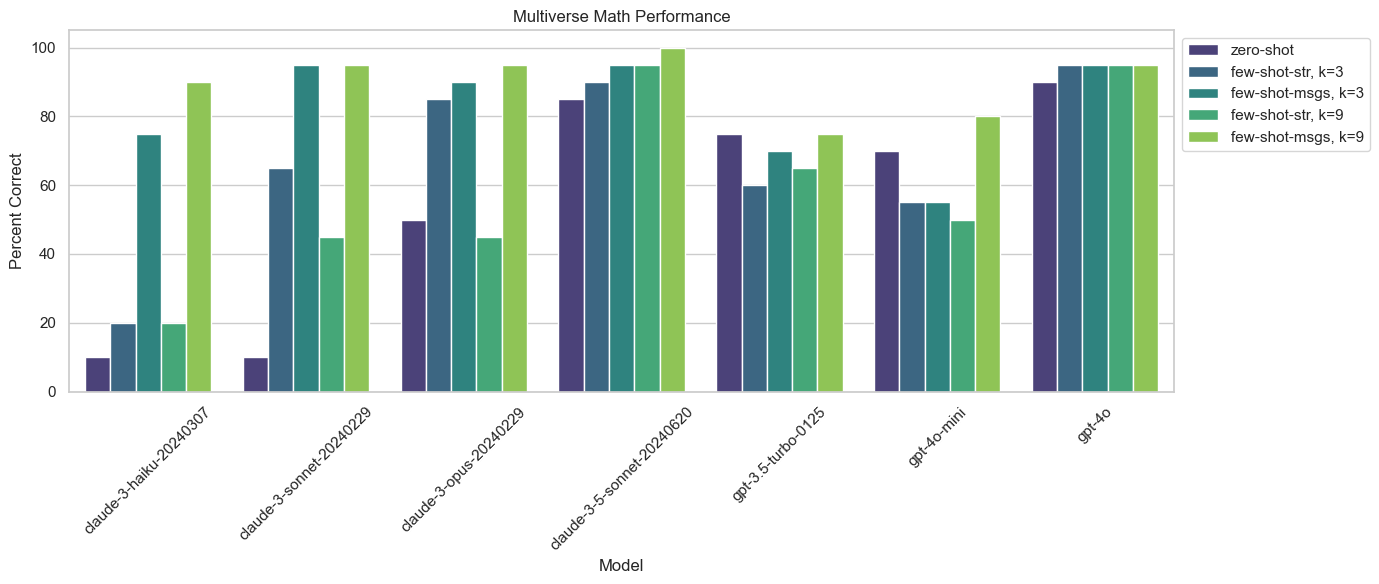多元宇宙数学的小样本实验#
本笔记本将介绍如何在多元宇宙数学数据集上运行小样本实验,你可以在此处找到该数据集。
设置#
首先,我们通过导入正确的库来设置我们的笔记本。
import datetime
import uuid
from langchain.agents import AgentExecutor, create_tool_calling_agent
from langchain.chat_models import init_chat_model
from langchain_core.messages import HumanMessage, SystemMessage, ToolMessage
from langchain_core.messages.utils import convert_to_messages
from langsmith.client import Client
from langsmith.evaluation import evaluate
from langchain_benchmarks import __version__, registry
from langchain_benchmarks.tool_usage.tasks.multiverse_math import *
# Define our LangSmith client so we have access to it throughout the rest of the notebook
client = Client()
列出测试#
接下来,我们可以列出我们将要运行实验的模型。由于新的通用可配置模型,这比以往任何时候都更容易。我们所需要做的就是保存一个模型名称和提供者列表,如下所示:
models = [
(
"claude-3-haiku-20240307",
"anthropic",
),
(
"claude-3-sonnet-20240229",
"anthropic",
),
(
"claude-3-opus-20240229",
"anthropic",
),
(
"claude-3-5-sonnet-20240620",
"anthropic",
),
("gpt-3.5-turbo-0125", "openai"),
(
"gpt-4o",
"openai",
),
("gpt-4o-mini", "openai"),
]
你可以随意添加/删除任何你想测试的模型。
重要提示:请确保你已安装正确的软件包(例如,如果使用“openai”提供的模型,则为langchain_openai),并设置正确的环境变量键(例如,如果使用“openai”提供的模型,则为OPENAI_API_KEY)。如果你不这样做,代码将无法工作!
定义辅助函数#
从数据集中提取小样本示例#
首先,我们需要定义一个函数,该函数接收来自数据集multiverse-math-examples-for-few-shot的示例,并将其转换为可供我们的模型使用的形式。在我们的示例中,我们将比较传入所有 9 个小样本示例与仅传入前 3 个示例的效果有何不同。
def get_few_shot_messages():
uncleaned_examples = [
e
for e in client.list_examples(
dataset_name="multiverse-math-examples-for-few-shot"
)
]
few_shot_messages = []
few_shot_first_three_messages = []
examples = []
for i in range(len(uncleaned_examples)):
converted_messages = convert_to_messages(
uncleaned_examples[i].outputs["output"]
)
examples.append(
# The message at index 1 is the human message asking the actual math question (0th message is system prompt)
{
"question": converted_messages[1].content,
"messages": [
m
for m in converted_messages
# The system prompt should only appear once at the beginning, so we remove it from few-shot examples
if isinstance(m, SystemMessage) == False
],
}
)
few_shot_messages += converted_messages
if i < 3:
few_shot_first_three_messages += converted_messages
return (
examples,
[m for m in few_shot_messages if not isinstance(m, SystemMessage)],
[m for m in few_shot_first_three_messages if not isinstance(m, SystemMessage)],
)
在本次实验中,我们还将比较将小样本示例作为字符串传入与作为消息列表传入的区别,因此我们定义了更多的辅助函数来实现这一点。
def turn_messages_to_str(few_shot_messages):
few_shot_str = ""
for m in few_shot_messages:
if isinstance(m.content, list):
few_shot_str += "<|im_start|>assistant"
for tool_use in m.content:
if "name" in tool_use:
few_shot_str += f"Use tool {tool_use['name']}, input: {', '.join(f'{k}:{v}' for k,v in tool_use['input'].items())}"
else:
few_shot_str += tool_use["text"]
few_shot_str += "\n"
few_shot_str += "\n<|im_end|>"
else:
if isinstance(m, HumanMessage):
few_shot_str += f"<|im_start|>user\n{m.content}\n<|im_end|>"
elif isinstance(m, ToolMessage):
few_shot_str += f"<|im_start|>tool\n{m.content}\n<|im_end|>"
else:
few_shot_str += f"<|im_start|>assistant\n{m.content}\n<|im_end|>"
few_shot_str += "\n"
return few_shot_str
def get_few_shot_str_from_messages(few_shot_messages, few_shot_first_three_messages):
few_shot_str = turn_messages_to_str(few_shot_messages)
few_shot_first_three_str = turn_messages_to_str(few_shot_first_three_messages)
return few_shot_str, few_shot_first_three_str
最后,我们将定义一个函数来返回我们将要使用的不同的小样本提示。
def get_prompts():
return [
(
client.pull_prompt("langchain-ai/multiverse-math-no-few-shot"),
"no-few-shot",
),
(
client.pull_prompt("langchain-ai/multiverse-math-few-shot-messages"),
"few-shot-messages",
),
(
client.pull_prompt("langchain-ai/multiverse-math-few-shot-str"),
"few-shot-string",
),
(
client.pull_prompt("langchain-ai/multiverse-math-few-shot-3-messages"),
"few-shot-three-messages",
),
(
client.pull_prompt("langchain-ai/multiverse-math-few-shot-3-str"),
"few-shot-three-strings",
),
]
现在我们准备好实际运行我们的实验了!
运行实验#
为了运行我们的实验,我们可以迭代我们的模型和提示,并使用evaluate函数将结果发送到 LangSmith。
def predict_from_callable(callable, instructions):
def predict(run):
return callable.invoke(
{"question": run["question"], "instructions": instructions}
)
return predict
experiment_uuid = uuid.uuid4().hex[:4]
today = datetime.date.today().isoformat()
task = MULTIVERSE_MATH
dataset_name = task.name
examples, few_shot_messages, few_shot_three_messages = get_few_shot_messages()
few_shot_str, few_shot_three_str = get_few_shot_str_from_messages(
few_shot_messages, few_shot_three_messages
)
prompts = get_prompts()
for model_name, model_provider in models:
model = init_chat_model(model_name, model_provider=model_provider, temperature=0)
print(f"Benchmarking {task.name} with model: {model_name}")
eval_config = task.get_eval_config()
for prompt, prompt_name in prompts[:-1]:
tools = task.create_environment().tools
agent = create_tool_calling_agent(model, tools, prompt)
agent_executor = AgentExecutor(
agent=agent, tools=tools, return_intermediate_steps=True
)
evaluate(
predict_from_callable(agent_executor, task.instructions),
data=dataset_name,
evaluators=eval_config.custom_evaluators,
max_concurrency=5,
metadata={
"model": model_name,
"id": experiment_uuid,
"task": task.name,
"date": today,
"langchain_benchmarks_version": __version__,
},
experiment_prefix=f"{model_name}-{task.name}-{prompt_name}",
)
可视化结果#
现在我们已经运行了评估,可以可视化我们的结果了。
projects = [
p
for p in client.list_projects(reference_dataset_name="Multiverse Math")
if p.metadata["id"] == experiment_uuid
]
models = set([p.name.split("-Multiverse")[0] for p in projects])
few_shot_type = set([p.name.split("Math-")[1] for p in projects])
few_shot_type = set([t[: t.rfind("-")] for t in few_shot_type])
results_dic = {}
for model in models:
model_results = []
for few_shot in few_shot_type:
experiment = [
p
for p in projects
if model + "-Multiverse" in p.name and few_shot in p.name
][0]
experiment_stats = client.get_run_stats(
project_ids=[experiment.id], is_root=True
)
model_results.append(
100
* experiment_stats["feedback_stats"]["correctness"]["avg"]
* (1 - experiment_stats["error_rate"])
)
results_dic[model] = model_results
import matplotlib.pyplot as plt
import numpy as np
import pandas as pd
import seaborn as sns
results = np.array([results_dic[model] for model in models])
# Create a DataFrame for Seaborn plotting
df = pd.DataFrame(results.T, columns=list(models))
df["Few Shot Type"] = list(few_shot_type)
df.iloc[[0, 1, 2, 3, 4]] = df.iloc[[3, 4, 0, 2, 1]].to_numpy()
df = df[df.columns[[3, 2, 0, 5, 6, 4, 1, 7]]]
# Melt the DataFrame to long format for Seaborn's barplot
df_melted = df.melt(
id_vars="Few Shot Type", var_name="Model", value_name="Percent Correct"
)
# Set up Seaborn parameters
plt.figure(figsize=(12, 6))
sns.set_theme(style="whitegrid")
# Plot using Seaborn
sns.barplot(
x="Model",
y="Percent Correct",
hue="Few Shot Type",
data=df_melted,
palette="viridis",
)
# Add labels and title
plt.xlabel("Model")
plt.ylabel("Percent Correct")
plt.title("Multiverse Math Performance")
plt.xticks(rotation=45)
plt.tight_layout()
legend_labels = {
"no-few-shot": "zero-shot",
"few-shot-messages": "few-shot-msgs, k=9",
"few-shot-string": "few-shot-str, k=9",
"few-shot-three-messages": "few-shot-msgs, k=3",
"few-shot-three-strings": "few-shot-str, k=3",
}
# Get the current handles and labels from the plot
handles, labels = plt.gca().get_legend_handles_labels()
labels = [legend_labels.get(label, label) for label in labels]
# Update the legend with the new labels
plt.legend(handles, labels, loc="upper left", bbox_to_anchor=(1, 1))
plt.show()

